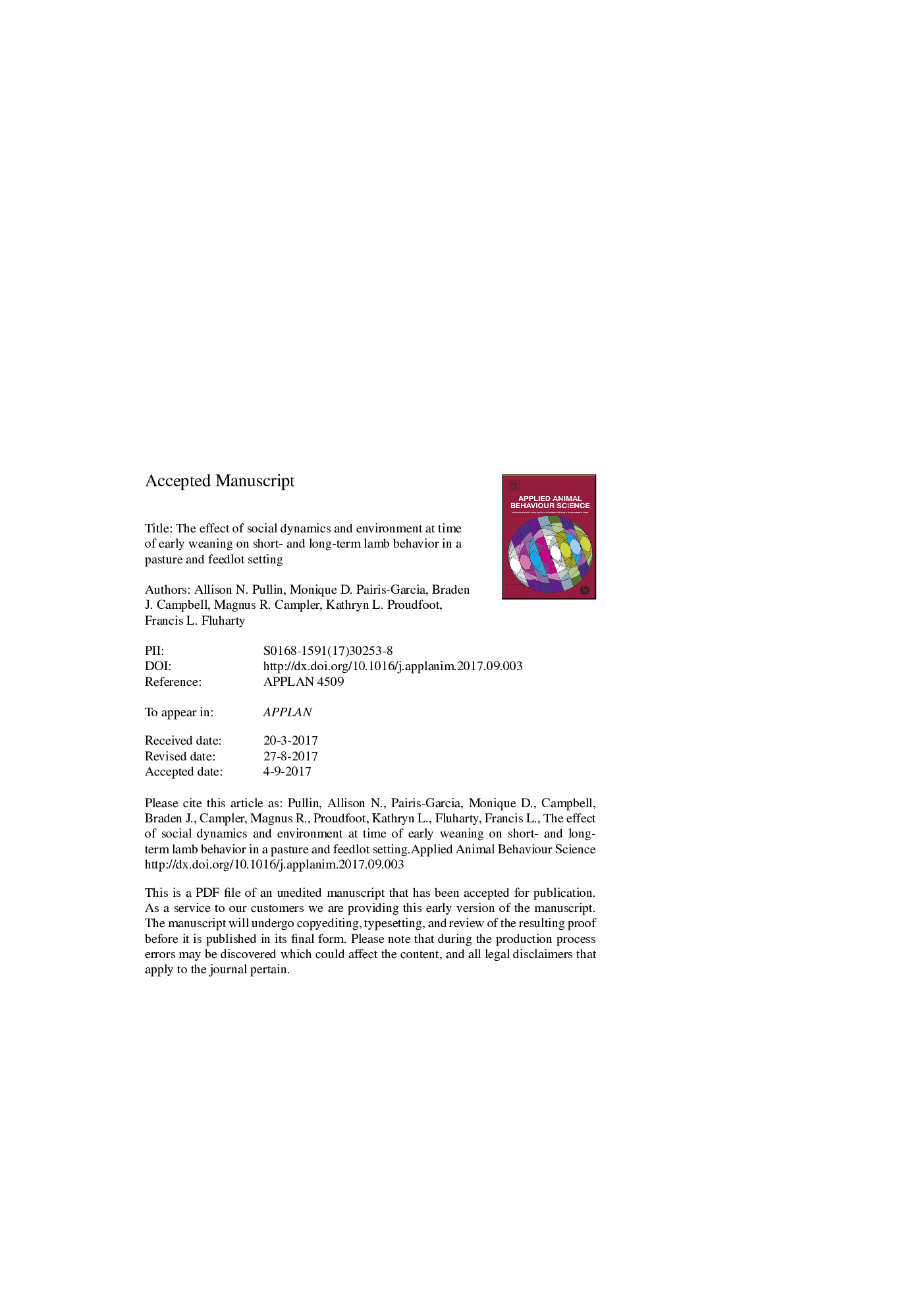| کد مقاله | کد نشریه | سال انتشار | مقاله انگلیسی | نسخه تمام متن |
|---|---|---|---|---|
| 8882880 | 1625309 | 2017 | 33 صفحه PDF | دانلود رایگان |
عنوان انگلیسی مقاله ISI
The effect of social dynamics and environment at time of early weaning on short- and long-term lamb behavior in a pasture and feedlot setting
ترجمه فارسی عنوان
تأثیر دینامیک اجتماعی و محیط زیست در زمان زایش زودرس بر رفتار کوتاه مدت و بلند مدت گوسفند در محیط گیاهان مرتعی و زراعی
دانلود مقاله + سفارش ترجمه
دانلود مقاله ISI انگلیسی
رایگان برای ایرانیان
کلمات کلیدی
موضوعات مرتبط
علوم زیستی و بیوفناوری
علوم کشاورزی و بیولوژیک
علوم دامی و جانورشناسی
چکیده انگلیسی
Lambs are commonly weaned around 60 d of age in the Eastern United States, but this age is also a time for lambs to apply long-term feeding strategies learned from adult animals. There is minimal evidence on how weaning strategies may affect long-term adaptation of feeding behavior. The objective of this study was to assess the effect of social and environmental factors at weaning on short- (3 d post-weaning) and long-term (8 wk post-weaning) feeding, lying, and standing idle behavior of lambs on pasture or in a feedlot. Two experiments tested this objective: Experiment 1 investigated social dynamics at time of weaning for lambs housed on pasture, and Experiment 2 investigated the effect of weaning into a feedlot compared to a pasture environment. At 60 d of age, 72 crossbred twin lambs were assigned to one of four treatments: lambs weaned and placed with similar-aged lambs onto pasture (W); lambs weaned and placed with similar-aged lambs and non-related adult ewes onto pasture (SF); lambs that remained with their dam on pasture (E); and lambs weaned and placed with similar-aged lambs into a feedlot (FL). Each treatment had three replicates with six lambs/replicate. Behavioral data were collected with instantaneous scan sampling for 15Â h/d for 55 d. During the first 3 d after weaning in Experiment 1, W lambs spent more time standing than SF lambs (PÂ =Â 0.03), and all lambs decreased standing idle time over the 3 d (PÂ <Â 0.0001). During the 8 wks after weaning, W and SF lambs spent more time grazing (PÂ =Â 0.03) and less time lying (PÂ =Â 0.02) compared to E lambs. In Experiment 2, feeding time of FL lambs increased on d 3 compared to d 1 and 2 (PÂ <Â 0.05). However, there was no effect of week on feeding, lying, or standing time over the long-term period (PÂ >Â 0.05). When the time-budgets of lambs from both experiments were compared, W lambs spent 39.2% more time grazing compared to the amount of time that FL lambs spent feeding. Results suggest that keeping non-related adult ewes (SF) with weaned lambs did not influence the grazing and lying behavior of lambs on pasture. Lambs that stayed with their dams and were weaned later (E) had the lowest grazing time, likely because they are still receiving milk. Lambs in the feedlot environment increased their time spent feeding in the first few days, suggesting an initial adaptation to stress after weaning.
ناشر
Database: Elsevier - ScienceDirect (ساینس دایرکت)
Journal: Applied Animal Behaviour Science - Volume 197, December 2017, Pages 32-39
Journal: Applied Animal Behaviour Science - Volume 197, December 2017, Pages 32-39
نویسندگان
Allison N. Pullin, Monique D. Pairis-Garcia, Braden J. Campbell, Magnus R. Campler, Kathryn L. Proudfoot, Francis L. Fluharty,
